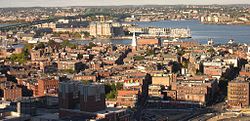
1804 New England hurricane
About this schools Wikipedia selection
SOS Children produced this website for schools as well as this video website about Africa. Click here for more information on SOS Children.
| Category 3 hurricane ( SSHS) | |
|---|---|
| Formed | bef. October 8, 1804 |
| Dissipated | aft. October 11, 1804 (extratropical after October 10, estimated) |
| Highest winds | 1-minute sustained: 115 mph (185 km/h) |
| Lowest pressure | 978 mbar ( hPa); 28.88 inHg |
| Fatalities | 9 direct |
| Damage | $100,000 (1804 USD) |
| Areas affected | Virginia, Mid-Atlantic States, New England, and southeastern Canada |
| Part of the 1804 Atlantic hurricane season | |
The Storm of October 1804, popularly known as the first reported "Snowicane", was a late-season major hurricane in the 1804 Atlantic hurricane season; it brought vast amounts of snow to New England as an extratropical storm in mid-October, and was the latter of the two tropical cyclones recorded that season.
It killed at least 9 people, and caused $100,000+ (1804 USD, $1.2 million 2005 USD) in damage across much of the Northeast Coast of the United States. In addition, several ships were wrecked in Boston's Harbour.
Meteorological history
Late in the 1804 Atlantic hurricane season, a major hurricane moved northwestward across the Western Atlantic. It passed by Virginia on October 8, with winds gusting at over 31 mph (50 km/h) reached as far as Norfolk. The system hit near Atlantic City, New Jersey, on October 9, and slowly curved east-northeastward, passing just north of New York City. After briefly passing through Connecticut and into Massachusetts, cool air was entrained in the circulation, and it became extratropical. It continued east as it passed through Boston into the Gulf of Maine. It was last mentioned two days later, on October 11, probably over Atlantic Canada. An estimated track of the storm can be viewed here.
Impact
The tropical cyclone brought blankets of snow to anywhere between New York and Southern Canada when it became extratropical. The storm brought heavy rain across the Atlantic states and southern New England, until it became extratropical and brought snow instead, in some areas up to two to three feet (610-910 mm). This was the first observation of snow from a landfalling hurricane, but not the last; Hurricane Ginny of 1963 brought up to 18 inches (400 mm) of snow to portions of Maine. In addition to the immense amounts of snow, the Storm of October 1804 toppled fruit orchards everywhere. Thousands of fowl perished, and cattle and sheep died by the hundreds because of the frigid temperature. In total, the extratropical storm killed 9 people and caused at least $100,000 (1804 USD, $1.2 million (2005 USD) in damage.
Southern Mid-Atlantic States
A vessel, the Rising Stakes, passed through the "dreadful squall" off of Cape Henry, but managed to escape without major damage. Many ships in Baltimore were beached after the rise and fall of the tide. In Atlantic City, New Jersey, a ship was driven ashore. In Trenton, a ferry capsized due to the high winds in the area. Philadelphia, Pennsylvania stated that one new ship sunk–quite a loss of money.
New York
New York City received the highest recorded amount of rain from the storm; the pressure dropped from 992.5 mbar to 977.6 mbar over night. Rainfall totals reached 2.77 inches (70 mm). Once the system had become extratropical, New York received large amounts of snow across the whole state. In Bemis, New York, in the western section of New York, snow and rain was reported to have fallen. Farther eastward, 18 inches (460 mm) of snow was received in Catskill Mountains.
Southern New England
In New Haven, Connecticut, a total rainfall accumulation of 3.66 inches (93 mm) was reported. After the storm became extratropical, Litchfield reported 3 inches (76 mm) of snow, while Goshen, CT, reported one foot (305 mm). Rhode Island experienced stronger winds than ever remembered in Providence.
In Massachusetts, 5-14 inches (127–356 mm) of snow was the average snowfall from the gale. But the Berkshires of Massachusetts reported two to three feet (610–910 mm) of snow. In Salem, 7 inches (178 mm) of rain was reported, more than ever before in a 24-hour period. The Gale of October 1804 was the worst tropical cyclone to affect Salem; it is not known if that record has been lost. The roof of the South Church in Danvers, Massachusetts, was lost. In Peabody, Massachusetts, over 30,000 unfinished bricks were ruined. Many buildings in Boston, Massachusetts were destroyed, and one person died because of fallen roofs. Several ships in Boston's harbour were wrecked, causing loss of life.
Northern New England
In Concord, New Hampshire, two feet (610 mm) of snow was recorded. Western New Hampshire along the Connecticut River was blanketed with 18 inches (46 cm) of snow. As for the damage, Portsmouth only lost trees and fences to the storm, but Rye lost a person to the storm. A dead woman was found on the beach, with her child still in her hands. Whether the child was dead or alive at the time is unknown. The Vermont Journal estimated 36 to 48 inches (910 to 120 mm) in areas around Windsor, Vermont, and Lunenburg, in northern Vermont, reported 20 inches (510 mm). Thomaston, Maine had a 60 acre (240,000 m²) lot of trees that was completely flattened by the time the storm had exited the area.
Boston
The Old North Church in Boston lost its steeple. The replacement steeple — 15feet (5 m) shorter than the original — eventually fell victim to Hurricane Carol in 1954, 150 years later. The third and current steeple is a replica of the first.


